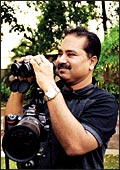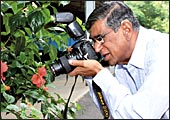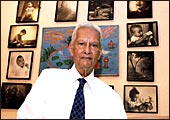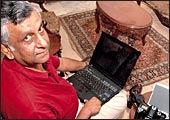|
Malvinder Mohan Singh
33/CEO & MD, Ranbaxy Laboratories
Cameras: Nikon FM, Nikon FM2 and Nikon F3
Singh's interest, which first became
evident in school, led to him winning the first prize at the inter-college
photo competition while at St Stephen's College, Delhi. He started
with a "locally-made camera" (he doesn't remember which one),
graduated to using Nikons from his early teens and now has the
Nikon FM, FM2 and F3. Singh inherited his interest in photography
from his father and maternal grandfather. He gets very little
time these days to devote to his hobby but still indulges himself
when on holiday. Over the years, Singh has built a huge collection
of wildlife, action, nature, architecture and portrait photographs
and prefers analogue to digital cameras though he does find the
latter more convenient.
 G.V.
Prasad G.V.
Prasad
45/Vice Chairman & CEO, Dr Reddy's Laboratories
Cameras: Nikon D70, Casio Exilim, Sony Cyber-shot
"I like to watch nature and I particularly like bird watching,"
says Prasad. Thrice every year, he travels out with his camera,
three lenses, a tripod, Leica binoculars and a Swarovski scope
to capture his magic moments. Prasad first became interested in
photography as a 12-year-old when he received a Kodak camera as
a gift. Eight years later, he was the proud owner of his first
professional camera, a Nikon EM. He has learnt the nuances of
photography on his own and by experimenting. "Technology is so
good these days that you get good pictures quite easily," he says.
He is also getting lucky. Recently, at his home in Banjara Hills
in Hyderabad, he spotted and shot (with his camera) a hornbill
and a kingfisher! Talk of killing two birds with one stone.
 K.
Mahesh K.
Mahesh
63/ CMD, Sundaram Brake Lining
Cameras: Nikon D70 and Nikon D200
He has been shooting pictures ever since he was seven. And in
the 56 years since, he has used a wide range of cameras-he started
with the Kodak Box Camera in 1951, used the Contax 35 mm range
finder camera from 1955 to 1970, the Rolleiflex from 1962 to 1968,
then moved over to the Cannon T90 SLR and now uses the Nikon D70
and the Nikon D200. How did he develop his interest in photography?
"It's in the genes," he says, adding that he grew up seeing his
father, uncle and cousin shooting photographs. He was able to
hone his skills by what he calls "asking for criticism and by
talking to people." Mahesh picked up the essence of shadow play
(in black and white pictures) through his association with Harry
Miller (the then chief photographer of The Indian Express in Chennai
in the early 60s). He began by shooting photographs of the Gods
(Chitra festival), but now prefers to shoot the people, and their
emotions, there. Over the years, his collection has grown to over
6,000 photographs which he plans to publish as a book soon.
 Basant
Kumar Birla Basant
Kumar Birla
86/ Chairman, B.K. Birla Group
Camera: Olympus Super Zoom 76 multi AF
His photographs capture nature; they capture youth; and most importantly,
they are sensitive and warm. As the 86-year-old patriarch of the
Birla family leafs through these magic moments, frozen in black
and white, his voice is full of emotion. "I was always fascinated
by photography. The new box camera aroused my interest," he says,
recalling how he took to photography in 1931 with a Kodak box
camera gifted to him by his father. "Gradually, the interest grew.
So did my capability and confidence," says B.K. babu (as people
refer to him affectionately and respectfully). Eventually, he
became the family photographer of sorts, recording the history
of the Birla family-and, by extension, the history of the development
of Indian industry-on a variety of cameras, among them the Contax,
Asahi Pentax and Nikon. In the 50s, he delved more deeply into
his hobby-leaving home on foot at the wee hours of the morning
and shooting for five-six hours at a stretch. "Maybe four or five
out of 20 shots used to be good," he recalls. "But that gave me
the confidence and the courage to participate in photography exhibitions
in big cities across the world. For an amateur photographer like
me, it is an honour to get an entry in such exhibitions. Many
of my photographs received high commendations and around half
a dozen even won top medals and awards," says Birla. He now uses
an Olympus Super Zoom 76 multi AF camera. "At my age, I cannot
manage bigger equipment than this," he says. His book of photographs,
Frozen in Time, was published in December 2003.
-Ritwik Mukherjee
 Utpal
Sen Gupta Utpal
Sen Gupta
57/President, Agro Tech Foods
Cameras: Canon S50, Nikon D70
It's thanks to Howard Buffett (Warren Buffett's son), who joined
the Agro Tech Foods board three years ago, that his interest in
photography was revived. Sen Gupta has been accompanying Buffett,
who, when in India, prefers to visit places that offer good opportunities
for photography. But Sen Gupta has been a keen photographer for
a long time. He acquired his first serious camera-a Minolta-30
years ago; 10 years later, he moved to the Canon T70 SLR. He bought
a Canon S50 four years ago and a Nikon D70, which he now uses,
two years ago. Needless to say, he has a huge collection of more
than 5,000 photographs-they range from shots taken during an Alaskan
cruise in June this year to profiles of Bastar tribals to photographs
of nature and wildlife. The piece de resistance: a clear shot
of a cheetah in South Africa about a year ago. How did he learn
the nuances of photography? "I read several books on the subject,
sought professional help and learnt by trial and error," he says.
Later this month, he and Buffet will be setting out for Bhutan
on their next photography expedition.
 Ajay
Piramal Ajay
Piramal
51/ Chairman, Nicholas Piramal India
Cameras: Nikon F100, Canon EOS 5D and Canon EOS 1D
He was always attracted to photography but it took a programme
on the subject organised by the Indo-American Society in 1973
to get him hooked. Result: he now has a rich collection of about
10,000 pictures-typically wildlife, nature and holidays. For wildlife
shoots, he usually carries two cameras with him. But learning
the nuances of photography was not easy. He found his way around
the problem by reading up on the subject and by relying on experience.
Today, he is seeking professional help and is learning new techniques,
including ways to improve pictures using Photoshop. His first
camera was a Nikon (F3 or F100, he doesn't remember). Piramal
prefers sticking with the Nikon family of cameras for still pictures.
In the digital space, he has opted for Canon EOS 5D and the Canon
EOS 1D.
|






 G.V.
Prasad
G.V.
Prasad K.
Mahesh
K.
Mahesh Basant
Kumar Birla
Basant
Kumar Birla Utpal
Sen Gupta
Utpal
Sen Gupta Ajay
Piramal
Ajay
Piramal